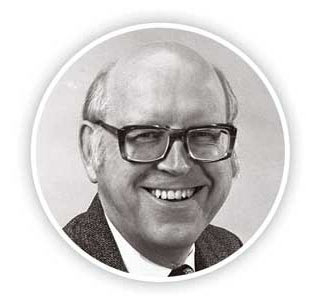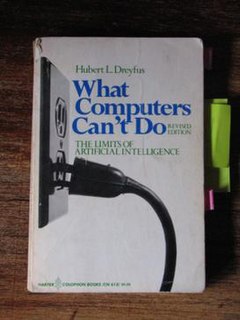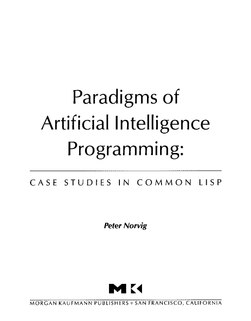The topic of this article may not meet Wikipedia's notability guideline for books .(September 2017) (Learn how and when to remove this template message) |
Human Problem Solving (1972) is a book by Allen Newell and Herbert A. Simon. [1]
The topic of this article may not meet Wikipedia's notability guideline for books .(September 2017) (Learn how and when to remove this template message) |
Human Problem Solving (1972) is a book by Allen Newell and Herbert A. Simon. [1]

Artificial intelligence (AI) is intelligence demonstrated by machines, unlike the natural intelligence displayed by humans and animals, which involves consciousness and emotionality. The distinction between the former and the latter categories is often revealed by the acronym chosen. 'Strong' AI is usually labelled as AGI while attempts to emulate 'natural' intelligence have been called ABI. Leading AI textbooks define the field as the study of "intelligent agents": any device that perceives its environment and takes actions that maximize its chance of successfully achieving its goals. Colloquially, the term "artificial intelligence" is often used to describe machines that mimic "cognitive" functions that humans associate with the human mind, such as "learning" and "problem solving".
Herbert Alexander Simon was an American economist, political scientist and cognitive psychologist, whose primary research interest was decision-making within organizations and is best known for the theories of "bounded rationality" and "satisficing". He received the Nobel Prize in Economics in 1978 and the Turing Award in 1975. His research was noted for its interdisciplinary nature and spanned across the fields of cognitive science, computer science, public administration, management, and political science. He was at Carnegie Mellon University for most of his career, from 1949 to 2001.

Allen Newell was a researcher in computer science and cognitive psychology at the RAND Corporation and at Carnegie Mellon University’s School of Computer Science, Tepper School of Business, and Department of Psychology. He contributed to the Information Processing Language (1956) and two of the earliest AI programs, the Logic Theory Machine (1956) and the General Problem Solver (1957). He was awarded the ACM's A.M. Turing Award along with Herbert A. Simon in 1975 for their basic contributions to artificial intelligence and the psychology of human cognition.
John Clifford Shaw was a systems programmer at the RAND Corporation. He is a coauthor of the first artificial intelligence program, the Logic Theorist, and was one of the developers of General Problem Solver and Information Processing Language. It is considered the true "father" of the JOSS language. One of the most significant events that occurred in the programming was the development of the concept of list processing by Allen Newell, Herbert A. Simon and Cliff Shaw during the development of the language IPL-V. He invented the linked list, which remains fundamental in many strands of modern computing technology.
The British Museum algorithm is a general approach to finding a solution by checking all possibilities one by one, beginning with the smallest. The term refers to a conceptual, not a practical, technique where the number of possibilities is enormous.
Movements in cognitive science are considered to be post-cognitivist if they are opposed to or move beyond the cognitivist theories posited by Noam Chomsky, Jerry Fodor, David Marr, and others.
General Problem Solver (GPS) is a computer program created in 1959 by Herbert A. Simon, J. C. Shaw, and Allen Newell intended to work as a universal problem solver machine. In contrast to the former Logic Theorist project, the GPS works with means–ends analysis.
Problem solving consists of using generic or ad hoc methods in an orderly manner to find solutions to problems. Some of the problem-solving techniques developed and used in philosophy, artificial intelligence, computer science, engineering, mathematics, medicine and societies in general are related to mental problem-solving techniques studied in psychology and cognitive sciences.
Problem finding means problem discovery. It is part of the larger problem process that includes problem shaping and problem solving. Problem finding requires intellectual vision and insight into what is missing. Problem finding plays a major role in application of creativity.
Problem shaping means revising a question so that the solution process can begin or continue. It is part of the larger problem process that includes problem finding and problem solving. Problem shaping often involves the application of critical thinking.
A physical symbol system takes physical patterns (symbols), combining them into structures (expressions) and manipulating them to produce new expressions.
Automated reasoning is an area of computer science and metalogic dedicated to understanding different aspects of reasoning. The study of automated reasoning helps produce computer programs that allow computers to reason completely, or nearly completely, automatically. Although automated reasoning is considered a sub-field of artificial intelligence, it also has connections with theoretical computer science and philosophy.
The history of Artificial Intelligence (AI) began in antiquity, with myths, stories and rumors of artificial beings endowed with intelligence or consciousness by master craftsmen. The seeds of modern AI were planted by classical philosophers who attempted to describe the process of human thinking as the mechanical manipulation of symbols. This work culminated in the invention of the programmable digital computer in the 1940s, a machine based on the abstract essence of mathematical reasoning. This device and the ideas behind it inspired a handful of scientists to begin seriously discussing the possibility of building an electronic brain.
John Robert Anderson is a Canadian-born American psychologist. He is currently professor of Psychology and Computer Science at Carnegie Mellon University.
Means–ends analysis (MEA) is a problem solving technique used commonly in artificial intelligence (AI) for limiting search in AI programs.

Hubert Dreyfus was a critic of artificial intelligence research. In a series of papers and books, including Alchemy and AI (1965), What Computers Can't Do and Mind over Machine (1986), he presented a pessimistic assessment of AI's progress and a critique of the philosophical foundations of the field. Dreyfus' objections are discussed in most introductions to the philosophy of artificial intelligence, including Russell & Norvig (2003), the standard AI textbook, and in Fearn (2007), a survey of contemporary philosophy.

Paradigms of AI Programming: Case Studies in Common Lisp (ISBN 1-55860-191-0) is a well-known programming book by Peter Norvig about artificial intelligence programming using Common Lisp.
Logic Theorist is a computer program written in 1956 by Allen Newell, Herbert A. Simon and Cliff Shaw. It was the first program deliberately engineered to perform automated reasoning and is called "the first artificial intelligence program". It would eventually prove 38 of the first 52 theorems in Whitehead and Russell's Principia Mathematica, and find new and more elegant proofs for some.
In mathematical optimization and computer science, heuristic is a technique designed for solving a problem more quickly when classic methods are too slow, or for finding an approximate solution when classic methods fail to find any exact solution. This is achieved by trading optimality, completeness, accuracy, or precision for speed. In a way, it can be considered a shortcut.
A solver is a piece of mathematical software, possibly in the form of a stand-alone computer program or as a software library, that 'solves' a mathematical problem. A solver takes problem descriptions in some sort of generic form and calculates their solution. In a solver, the emphasis is on creating a program or library that can easily be applied to other problems of similar type.